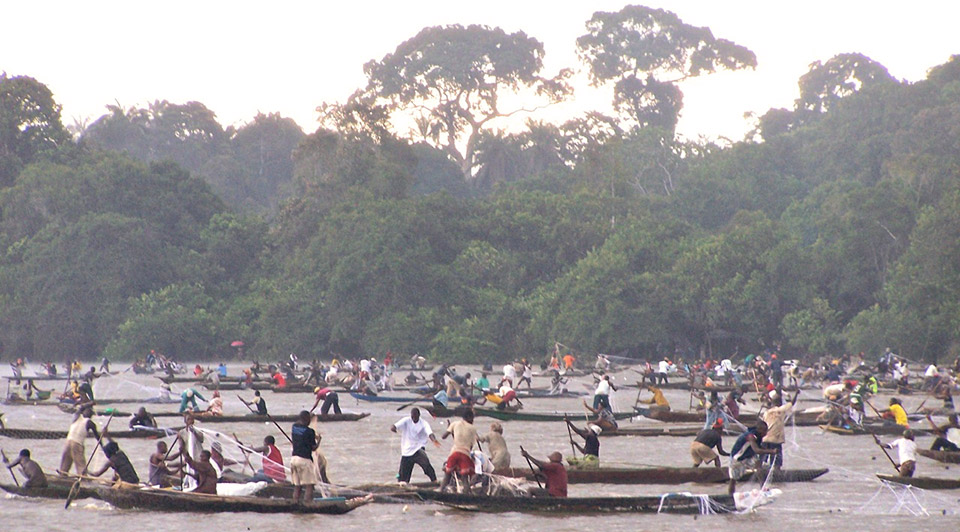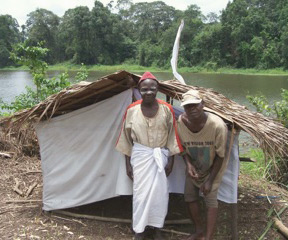સાઇટ
છેલ્લા પર 400 વર્ષ, ઇકોલોજીકલ રીતે સમૃદ્ધ નાઇજર ડેલ્ટાએ પામ ઓઇલ દ્વારા વૈશ્વિક અર્થતંત્રમાં મહત્વની ભૂમિકા ભજવી છે, ગુલામોનો વેપાર અને હવે અશ્મિભૂત ઇંધણ દ્વારા. આર્થિક રીતે શક્તિશાળી હિસ્સેદારો હજુ પણ ડેલ્ટાની પ્રાકૃતિક ઇકોસિસ્ટમ્સ માટે જોખમ ઊભું કરે છે, આમ સ્વદેશી લોકોના બે મુખ્ય જૂથોની સાંસ્કૃતિક પરંપરાઓ અને પ્રદેશોને અસર કરે છે. બિસેની લોકો ડેલ્ટાના ઉપરના પ્રદેશો પર કબજો કરે છે, જ્યારે ઓસિયામા લોકો નીચલી માર્શ ફોરેસ્ટ ઝોનમાં વસે છે. બંને જૂથો તેમની જમીનો અને ખાસ કરીને તેમના તળાવોને પવિત્ર માને છે. બે મહત્વપૂર્ણ તળાવો અદિગ્બે છે (ઓસિયામા લોકો વસે છે) અને એસિરીબી (બિસેની લોકો વસે છે). બંને તેમના ઘર છે પવિત્ર ભાઈઓ: મગરો.
ઇકોલોજી અને જૈવવિવિધતા
નાઇજર ડેલ્ટા તેના અનન્ય ઇકોસિસ્ટમ માટે જાણીતું છે; તે એક મહત્વપૂર્ણ ઉષ્ણકટિબંધીય ઝોનનો ભાગ છે, રાષ્ટ્રીય સ્તરે જોખમી મગરનું ઘર (ઑસ્ટિઓલેમસ ટેટ્રાસ્પિસ). તેમાં IUCN રેડ લિસ્ટની વિવિધ પ્રજાતિઓ પણ છે, જેમ કે રેડ કોલોબસ મંકી (પીલિયોકોલોબસ પેનન્ટી એપિની), સ્કેટલર્સ ગ્યુનોન (સર્કોપીથેકસ સ્ક્લેટેરી) અને સ્પોટેડ નેક ઓટર (પાણીના ફોલ્લીઓ). આ પ્રદેશ દક્ષિણની ભરતીના તાજા પાણી અથવા માર્શ ફોરેસ્ટ ઝોન અને ઇનલેન્ડ ફ્લડ ફોરેસ્ટ ઝોન વચ્ચે વહેંચાયેલો છે.. તાજેતરમાં, રહેવાસીઓએ ગ્રાસ બરહેડ સેજ જેવી આક્રમક પ્રજાતિઓ નોંધી છે (ઓક્સીકેરિયમ ક્યુબેનસિસ).
ધમકીઓ
કેટલાક પરિબળો જૈવવિવિધતાને જોખમમાં મૂકે છે, તેમજ એડિગ્બે અને એસિરીબી તળાવોની સ્વદેશી સંસ્કૃતિઓ. સમુદાયના સભ્યો વધુને વધુ આજીવિકાની તકો સાથે જોડાય છે - ઉદાહરણ તરીકે ડાયનામાઈટ માછીમારી- જે તેમની જીવનશૈલીમાં પરિવર્તન લાવે છે જેના કારણે તેઓ તેમની પરંપરાગત માન્યતાઓને છૂટછાટ આપે છે. ઉદાહરણ તરીકે પરંપરાગત નેતૃત્વનું નબળું પડવું એ સામાજિક અથવા રાજકીય જૂથોને સત્તા અને પ્રભાવની તકો પૂરી પાડે છે જે અન્ય મૂલ્યોને વહેંચે છે. તેલ કંપનીઓમાં નોકરીની તકોની શોધમાં આ પ્રદેશમાં પ્રવેશતા સ્થળાંતર કરનારાઓ ખાદ્ય પુરવઠા માટે સ્થાનિક મત્સ્યોદ્યોગ પર વધુ માંગ કરે છે. ધાર્મિક અભિગમમાં ફેરફારો પવિત્ર મગરોના પરંપરાગત અને પ્રતિષ્ઠિત મૂલ્યો અને સામાન્ય રીતે સ્થાનિક વનસ્પતિ અને પ્રાણીસૃષ્ટિ માટેના આદરમાં ઘટાડો કરે છે..
સંરક્ષકો
બંને સમુદાયોના કોસ્મોલોજીમાં વાસ્તવિકતાના બે ક્ષેત્રો અસ્તિત્વમાં છે: દૃશ્યમાન વિશ્વ (ડાબી) અને અદ્રશ્ય વિશ્વ, અથવા આત્માઓની ભૂમિ (થીમ્સ). દૃશ્યમાન વિશ્વ કુદરતી ઇન્દ્રિયોથી જોવામાં આવે છે અને તેમાં મનુષ્યો છે, છોડ અને પ્રાણીઓ. અદ્રશ્ય વિશ્વ આત્માઓથી બનેલું છે જે ભૌતિક ઇન્દ્રિયો દ્વારા જોવામાં આવતું નથી. પવિત્ર સરોવરોના રખેવાળો એ પણ સુનિશ્ચિત કરે છે કે પરંપરાગત નિયમો અને રિવાજો પરિપૂર્ણ થાય છે જેથી બંને વિશ્વ એક સાથે સુમેળમાં રહી શકે.. તેઓ સુનિશ્ચિત કરે છે કે જે સરોવરોને પ્રવેશ માટે પ્રતિબંધિત છે તેના સંબંધમાં પ્રોટોકોલનું પાલન કરવામાં આવે છે (હા), અને તળાવો જે સુલભ છે (અવેયા). આ પરંપરાગત નિયમોના પરિણામે, મગર અને ગરોળી જેવા ચોક્કસ પ્રાણીઓને કોઈ નુકસાન થતું નથી અને લાંબા સમયથી આ પ્રદેશમાં સારી રીતે સુરક્ષિત છે. આ પ્રાણીઓને ભાઈ તરીકે જોવામાં આવે છે અને સ્થાનિક લોકો તેમને નુકસાન પહોંચાડવા માંગતા નથી અને તેઓ એન્થ્રોમોર્ફિઝ્ડ છે અને હકીકતમાં તેઓને ભાઈ તરીકે જોવામાં આવે છે.. જો કોઈ આકસ્મિક રીતે અથવા હેતુપૂર્વક તેમાંથી એકને મારી નાખે છે, તેઓ મનુષ્યોની જેમ સંપૂર્ણ અંતિમ સંસ્કાર મેળવે છે અને તેને જીવંત નમૂના સાથે બદલવો પડે છે.
“મગર આપણા ભાઈ જેવો છે, અને તેથી નુકસાન પહોંચાડી શકાતું નથી" - અનામી ઓસિયામા વ્યક્તિ.
દ્રષ્ટિ
આ તાજા પાણીની ઇકોસિસ્ટમના ટકાઉ સંચાલનમાં સ્થાનિક સમુદાયોના પરંપરાગત કારભારી મોડેલને અનુકૂલન કરીને મોટા પ્રમાણમાં સુધારો કરવામાં આવશે.. વ્યૂહરચનાઓ રોટેશનલ ફિશિંગની પરંપરાગત પ્રણાલીને જાળવવા પર કેન્દ્રિત હોવી જોઈએ કારણ કે માછીમારીની ઘટનાઓ વચ્ચેનો સમય વિરામ મત્સ્યઉદ્યોગ અને જળચર સંસાધનોના કાયાકલ્પને પ્રોત્સાહિત કરે છે.. આ બદલામાં ઉચ્ચ ઉત્પાદકતા તરફ દોરી જાય છે અને આ તળાવોની ઉચ્ચ જૈવિક વિવિધતામાં ફાળો આપે છે.
ક્રિયા
સ્થાનિક કાર્યક્રમોનું વધુ આયોજન અને પરંપરાગત નેતૃત્વની માન્યતા વધુ સફળ સહયોગને લાભ આપી શકે છે. કેટલાક વૈજ્ઞાનિક અભ્યાસ, પ્રદેશના સ્વદેશી જ્ઞાનનું મૂલ્યાંકન, દર્શાવો કે પ્રકૃતિ અને સંસ્કૃતિ નજીકથી સંબંધિત છે અને પરંપરાગત શાસન અને સંચાલનના મૂલ્યનો પુરાવો છે. તેઓ સાંસ્કૃતિક મૂલ્યો અને સમુદાયની ભાગીદારી સંબંધિત રામસર સંમેલનના ઠરાવો લાગુ કરવાની ભલામણ કરે છે.
નીતિ અને કાયદો
સ્થાનિક નીતિ અને કાનૂની સાધનો સ્થાનિક લોકો દ્વારા પરંપરાગત રીતે સંરક્ષિત વિસ્તારોમાં તેમના અધિકારો માટે બહુ ઓછો હિસ્સો ધરાવે છે. વિસ્તારમાં ટકાઉ વિકાસ માટે નવા કાયદા મહત્વપૂર્ણ બની શકે છે. ફ્રેમવર્ક જરૂરી છે, ઠરાવના અમલીકરણ માટે સાધનો પ્રદાન કરે છે 61/295 સ્વદેશી લોકોના અધિકારો પર યુએનની ઘોષણા. પણ મહત્વપૂર્ણ, કસ્ટોડિયન અને સ્વદેશી લોકોની તરફેણમાં દેશના જમીન-ઉપયોગ કાયદાની સમીક્ષા છે.
સંયુક્ત
આ પ્રદેશમાં સરકારની સંડોવણીને સામાન્ય રીતે શંકાની નજરે ગણવામાં આવે છે. સરકાર હસ્તક્ષેપ કરી શકે છે, જો કે, ગ્રામવાસીઓ પાસે તેમના સંસાધનોનું રક્ષણ અથવા સંચાલન કરવાની ક્ષમતા ન હોય તેવા સંજોગોમાં વિનંતી કરવામાં આવે, પરંતુ માલિકી જાળવવા અને તેમને નિયંત્રિત કરવાની મંજૂરી છે. સંસાધનોના સહ-વ્યવસ્થાપન માટે બહુ-સ્તરીય ક્ષમતા નિર્માણ કરવાની આ એક તક છે.
સંરક્ષણ સાધનો
પસંદગીયુક્ત માછીમારી એ સૌથી અગ્રણી સંરક્ષણ સાધન છે જે હાલમાં તૈનાત છે પરંતુ તે જરૂરી નથી. વિસ્તારમાં મોટા ખેલાડીઓની વધતી શક્તિઓનો સામનો કરવા, સરકાર સમુદાયો સાથે નિષ્ઠા મેળવી શકે છે અને જ્ઞાન વહેંચવા અને જૈવવિવિધતા પર દેખરેખ રાખવા માટે ક્ષમતા નિર્માણમાં મદદ કરી શકે છે. જૂથ તાલીમ એ તમામ સંસાધન વપરાશકર્તાઓની પારસ્પરિક સમજને સુનિશ્ચિત કરવાની અસરકારક રીત હોઈ શકે છે, ખાસ કરીને લઘુમતી જૂથોના પરંપરાગત શાસન અને સંચાલનને ઓળખો.
પરિણામો
કેટલાક સમુદાયોમાં મજબૂત સામાજિક સંકલન હોય છે અને તેઓ અન્ય લોકોને સરકાર સાથે ક્ષમતા નિર્માણ માટે ખુલ્લાં પાડવા માટે પ્રેરણા આપે છે. વૈજ્ઞાનિકોએ મહત્વની જાણકારીઓ એકઠી કરી છે, સંરક્ષકોને પરંપરાગત માન્યતા પ્રણાલી જાળવવા અને પ્રકૃતિ સંરક્ષણ માટે સંગઠિત પગલાં લેવા માટે મદદ કરવી. આમાંના મોટાભાગના પરિણામો પરંપરાગત રિવાજોના મૂલ્યને પુનઃપુષ્ટ કરે છે. સંરક્ષકોની ભૂમિકા તેમજ કેટલાક કિસ્સાઓમાં તેમના જ્ઞાને ઇકોસિસ્ટમની કામગીરીમાં વધુ સારી સમજ આપવામાં ફાળો આપ્યો છે.. સહયોગ સંદેશાવ્યવહાર માટે તેમની નિખાલસતા ભવિષ્યમાં આ પવિત્ર કુદરતી સ્થળોને સુરક્ષિત કરવામાં મદદ કરશે.
- સરનામું, ઇ.ડી., તપાસો, આર.એ., માર્ટિન, એ.એમ., ઓબિરેકે, એલ., એસ, એમ, ઘણું, પી, ઓટો ફાર્માસિસ્ટ, ડી. 2010. મગર આપણો ભાઈ છે?: નાઇજર ડેલ્ટાના પવિત્ર તળાવો, સંરક્ષણ વ્યવસ્થાપન માટે અસરો. માં બી. Verschuuren, આર. વાઇલ્ડ, જે.એ.. મેકનીલે, જી. ઓવીઇડો (ઇડીએસ.) પવિત્ર કુદરતી Sites: કુદરત અને સંસ્કૃતિ સંરક્ષણ. પૃથ્વી સ્કેન, લન્ડન.
- ઠરાવ 61/295 ના સ્વદેશી લોકોના અધિકારો પર યુએનની ઘોષણા.
- રામસર ઠરાવ VII.8: વેટલેન્ડ્સના સંચાલનમાં સ્થાનિક સમુદાયો અને સ્થાનિક લોકોની ભાગીદારી સ્થાપિત કરવા અને મજબૂત કરવા માટેની માર્ગદર્શિકા.
- રામસર ઠરાવ IX.21: વેટલેન્ડ્સના સાંસ્કૃતિક મૂલ્યોને ધ્યાનમાં લેવું
- Verschuuren, બી, (તૈયારીમાં) આધ્યાત્મિક સેવાઓ: વેટલેન્ડ્સના ધાર્મિક પાસાઓ. માં: મેક્સ ફિનલેસન (સંપાદન કરવું) વેટલેન્ડ્સનો જ્ઞાનકોશ, સ્પ્રિંગર 2013





